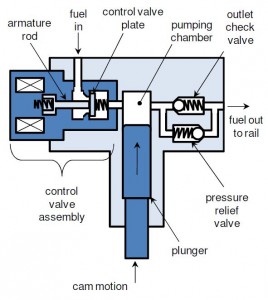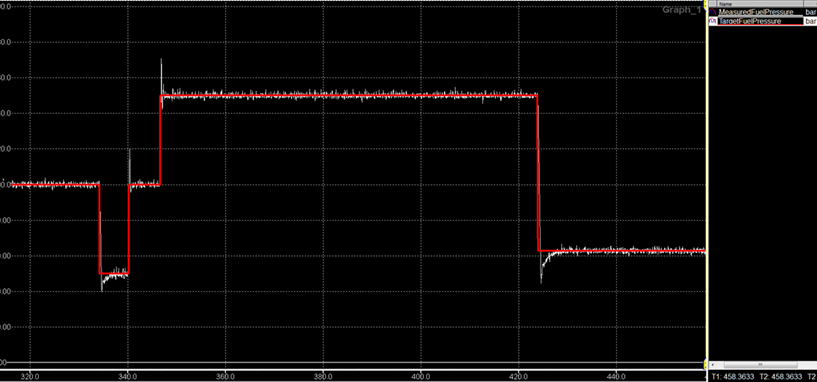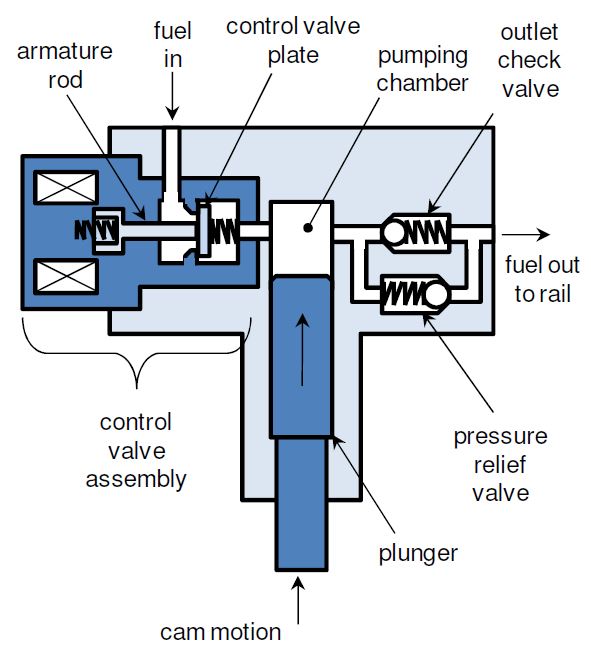
The fuel rail pressure in a GDI engine is provided by a cam-driven variable stroke high pressure fuel pump. In typical designs, the volume of fuel pumped is controlled by a Flow Control Valve (FCV) located on the inlet of the pump. The valve is electronically controlled by the engine control unit to regulate fuel rail pressure. The operation of the FCV is unique because its control must be synchronous with the crankshaft position. Typical GDI fuel pumps have three lobes per camshaft revolution that stroke the pump. Fuel pressure is regulated by controlling the FCV during the stroke of the pump to regulate how much of the stroke is allowed to draw fuel into the pumping chamber.
Fuel enters the pumping chamber during the downward motion of the plunger through the open FCV. The FCV opens during this time due to the valve being held open by the spring and the suction of the piston. This results in a lower pressure in the pumping chamber as compared to the fuel inlet, and fuel flows into the chamber.
If the FCV solenoid remains de-energized during the upward stroke of the cam and plunger, the valve stays open due to the spring force, preventing the pump from developing pressure. The GDI fuel pump thus delivers no fuel to the fuel rail.
If the FCV solenoid is energized during the upward stroke, the FCV closes and the low pressure inlet is sealed off from the pumping chamber. This allows high pressure to be developed in the chamber. Once enough pressure has been developed, the outlet check valve opens and pressurized fuel is delivered to the fuel rail.
The quantity of fuel delivered by the GDI fuel pump can be adjusted by controlling the exact moment in the upward plunger stroke that the FCV solenoid is energized. The earlier the valve closes, the higher the quantity of fuel delivered to the fuel rail.

Fig 1: Zero Fuel Pressure

Fig 2: Mid-range Fuel Pressure

Fig 3: Maximum Fuel Pressure
Typically, a relief path using a pressure relief valve is also present to prevent over-pressurization of the fuel rail. This relief path is not normally used for fuel pressure control. The relief pressure setting is set higher than the maximum pressure expected during normal engine operation. Operating the relief valve in this manner results in higher engine efficiency through reduced fuel pump drive losses. For example, during a deceleration fuel cut, no fuel will flow out of the fuel rail because the injectors are disabled. In such a case, the FCV solenoid can be left de-energized and the rail pressure will remain at its previous set point without the fuel pump adding any additional fuel, thus saving pumping work.
GDI Fuel Pump Control Algorithm
To create a closed loop pressure control algorithm using an angularly driven GDI fuel pump we start with developing a traditional feedforward and feedback control loop. Determination of the fuel rail pressure target is not covered here, but traditionally it is based upon engine speed and torque demand.
Dana uses model based controls implemented using the Simulink development environment and the OpenECU blockset to create all the control commands necessary for use with a GDI pump. The control algorithm implements the fuel rail pressure target, and performs closed loop control of the fuel pressure.

Fig 4: Feedforward & Feedback Control
If the actual fuel rail pressure is below the target, then the control effort is translated into a start of current angle for the FCV solenoid. This angle is specified relative to the TDC position of the fuel pump plunger. The higher the effort required, the earlier will be the ‘on-angle’ of the FCV solenoid. This transformation from effort to angular control is fully calibratable and can be characterized for different fuel pumps.

Fig 5: FCV Angular control
The duration for which the FCV is to be energized is also calculated based on engine speed and the target effort. The duration is not a critical parameter in GDI pump control. The FCV solenoid must be energized long enough so that enough pressure is developed in the pumping chamber to prevent the FCV from opening till the plunger begins its downward stroke. By relying on the pressure in the pumping chamber to keep the FCV closed the on-time of the FCV circuit can be reduced which reduces current draw from the ECU and limits the heating of the ECU.
The ‘on-angle’ and duration are the used to calculate the ‘off-angle’ for the FCV solenoid, and these are fed to the OpenECU Simulink block. The OpenECU driver software will schedule the angular tasks such that the FCV is energized and de-energized at the desired crankshaft positions.

